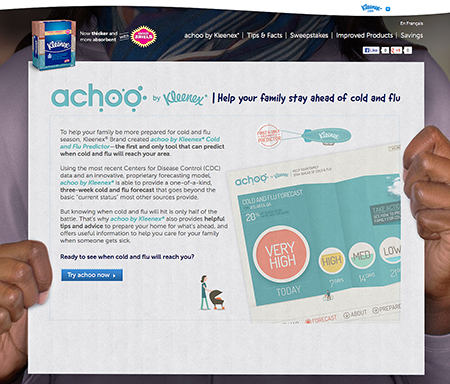In what would appear to be a business-undermining effort, CPG firm Kimberly-Clark is promoting tissues and the flu season with a tracker that provides users with a tool that offers a regional influenza forecast in way that mimics the local weather report.
Announced Tuesday, the “achoo by Kleenex” tool is another take on Big Data and illness trends that Google searches have helped spawn of late. The requirements: enter a zip code, provide home illness info, and hit enter. The result: a map of the US filled with colored dots, and a color scale that shows prevalence and a “you are here” note that provides additional context.
The tool then goes more local, and serves up a cold and flu forecast for the week, 14 days and 21 days ahead, making this level of information as much a travelcast as it is an at-home resource. However, taking a cue from Big Data, the achoo tool seeks to go micro as well as macro, and offers up a tissue calculator that estimates how many boxes of tissues a family will go through during the cold and flu season, which spans from fall through spring. Two adults, one kid: 25 boxes. Two adults, five kids: 35 boxes.
Not surprisingly, a coupon is on tap, but the tool also provides info about where to get a flu shot. Using the Haymarket Media zip code as a test generated mixed results, with directions to visit a local Duane Reade drug store as well as some unrelated businesses, like photography studios. Kimberly-Clark was not able to respond to queries by press time.
While the achoo resource is a fun interface, the CPG company’s efforts represent the fusion of data and creative that the pharmaceutical industry tries to flirt with. In this case, fusing potentially dry information about cold and flu with visuals that provide a patient-centric perspective (“Is it near me, as in the next door over?” or, “I want to go on vacation next month. Will I get sick here?”) along with health-related information, such as vaccine locations and tips for how to keep colds at bay (soap). At the same time, it flips the patient perspective into a larger, Big-Data one, which is, how their personal health may be part of a larger trend, without disrupting the “it’s about me and my family” narrative.
The last flu season, which officially ends September 28, 2013, was particularly harsh, as well as a lengthy one, kicking off four weeks earlier than usual. CDC said the elevated rate of infection lasted 15 weeks back-to-back, which is “slightly longer than average,” and that the US only returned to below-baseline infection rates in March, the first time since December 2012.
A CVS report released in August showed that the 2012-2013 flu season swayed individuals in favor of the flu vaccine, but not for themselves. Instead, consumers told CVS is was a social good, best pursued by others.







